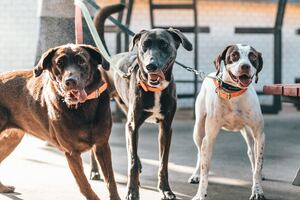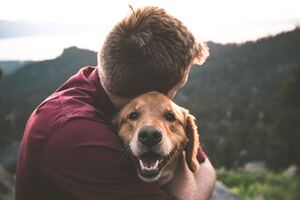
Training a rescue dog rewards the owner and the pet with a fulfilling experience.
More...
Every year, rescuers save thousands of dogs from neglectful or abusive situations.
Furthermore, these dogs often require specialized training to help them recover from their traumas and become well-adjusted pets.
Training rescue dogs requires patience, consistency, and a deep understanding of canine behavior.
Active engagement in acquiring effective methodologies leads rescued dogs to develop vital capabilities that enable them to blossom as devoted companions.
This post will provide a brief overview of the essential components involved in training rescue dogs.

1.) Train a Rescue Dog With Patience and Understanding
Training a rescue dog requires patience and understanding, as many have experienced trauma or neglect.
Establishing trust with the dog before even starting training sessions is crucial.
Likewise, you can achieve this by spending quality time with your dog and giving it ample attention, care, and affection.
Moreover, one must maintain a consistent routine when training a rescue dog.
Besides, these dogs often thrive under structure and predictability since they may not have had much stability in their previous environment.
Therefore, setting clear rules and boundaries will help them feel secure and less anxious.
In addition, games that stimulate the cognitive abilities of rescue dogs can have positive effects.
Rescuing a dog is compassionate but challenging. With patience, routine consistency, professional guidance, and training, your rescue pup can become a loyal furry friend for years!
2.) Effective Positive Reinforcement for Training a Rescue Dog
It would help to address the emotional baggage of rescue dogs before they can thrive in a new environment.
In addition, effective incentive-driven training techniques can make it easier to train a rescue dog, despite the challenges.
When rewarding good behavior with treats or praise, you will encourage your furry friend's progress and help build a strong bond between you.
With that said, these simple gestures can go a long way in making your rescue dog feel loved and appreciated.

3.) Giving Positive Reinforcement
Praising and rewarding good behavior helps to build the dog's confidence, trust, and motivation to learn new skills.
Using treats, verbal cues, or physical affection as affirmative conditioning will encourage your rescue dog to repeat the actions that earned them praise.
This positive training approach creates a harmonious bond between you and your fluffy friend while improving their well-being.
By consistently utilizing constructive teaching techniques during training sessions, you can teach your rescue dog basic obedience commands such as sit, stay, and come here, which are essential for safety and socialization.
4.) Improving Your Rescue Dog’s Behavior Through Training
Maintaining a steadfast approach in training a rescue dog and establishing definite limits that are adhered to could prevent the emergence of behavioral problems later on.
Your rescue dog will learn the expected behavior and respond positively to training by establishing clear rules and routines.
To train your rescue dog effectively, identify its needs and limitations.
Use incentivized learning techniques such as rewards and praises to encourage good behavior while consistently correcting negative behaviors.

5.) Personalized Training for Rescue Dogs
It's essential to tailor your approach to training rescue dogs based on their unique personality traits, and some may require extra attention or specialized techniques depending on their past experiences or behavioral tendencies.
Moreover, you can help your canine companion overcome any behavioral issues they may have encountered in their previous environment.
Therefore, it is essential to understand that every rescue dog has their own history and personality traits.
Providing the right balance of structure, freedom, and positive interactions to build trust is imperative when tailoring the training program for your rescue pup.
6.) Understanding Canine Behavior and Body Language
Training a rescue dog requires understanding canine behavior and body language.
Firstly, observing a rescue dog's behavior helps to understand its personality.
Additionally, it is crucial to learn how they communicate through body language.
Secondly, reward-based training techniques effectively build trust and rapport with the dog.
Moreover, taking time to create an engaging environment can stimulate mental and physical activity.
When working with a rescue dog that is experiencing behavioral changes, it is crucial to have patience as a critical factor.
7.) Creating a Safe Space for Your Dog
Establishing a secure environment is crucial when training rescue dogs.
Moreover, this involves setting up routines and limits, offering cozy bedding and toys, and providing ample positive reinforcement.
Training should also be conducted in a calm environment with minimal distractions to ensure the dog feels secure while learning new behaviors.
Creating a designated space for them ensures your rescue dog feels safe and secure.
A comfortable bed in a peaceful area of your home can create an ideal space for dogs to seek refuge during distress or unease.
Additionally, adding familiar scents like their favorite toys or blankets can further promote feelings of comfort and security.

8.) Developing Consistent Routines and Habits
Developing consistent routines and habits is essential when training a rescue dog.
By establishing regular feeding times, exercise schedules, and designated potty breaks, the dog will quickly learn what to expect from their new environment.
Setting clear boundaries and expectations can help you gain the trust of your new four-legged friend and create a foundation for their success in their new home.
Creating structure and predictability allows for a sense of security in the rescue dog's life.
9.) Establishing Dominance Without Punishment
Establishing authority with a rescued canine can be challenging, especially when avoiding punishment while teaching.
One effective way is through treat-based training techniques such as rewarding good behavior with treats or praise.
Another proven method is showing your rescue dog love and patience during training sessions.
Using clear commands and consistency in training your dog, setting boundaries, and asserting yourself as the pack's leader are essential steps to ensuring effective canine behavior.
Building trust with your pet pooch makes them more likely to listen and follow your lead.
Remember that dogs respond better to positive reinforcement than punishment, so stay patient and consistent and reward their good behavior for lasting results.
10.) Rescue Dog Training Success
To effectively train a rescue dog, it is crucial to maintain discipline with unwavering consistency.
Therefore, this means ensuring all family members and caregivers are on the same page when enforcing rules and boundaries for your trusty pet.
Equally important, you should use motivational training to encourage good behavior.
Furthermore, it is crucial to avoid confusing or mixed signals during training.
In brief, patience and persistence are essential when working with a rescue dog that may have had previous trauma or neglect.

11.) Encouraging Good Behaviors
Promoting positive behavior is essential in effectively assimilating a rescued dog into your household, even though training them can pose a challenge.
To promote positive habits, use regular reinforcement techniques such as verbal praise, treats, or toys when they exhibit desired actions like sitting or staying still.
Developing a routine and employing affirmative reinforcement can instill positive conduct in your adopted canine.
Moreover, it's imperative to teach them basic commands that could save their lives, such as "come" or "stay."
By doing this, you can encourage healthy communication with your pet, guarantee their safety, and establish trust between the two of you.

12.) Addressing Behavioral Issues
Dogs who have experienced trauma may exhibit challenging behaviors such as anxiety or aggression towards people or other animals.
One practical approach is understanding the underlying cause of the behavioral issue, such as fear or anxiety, and addressing it through desensitization and counter-conditioning techniques.
To effectively address these problems, one must use a mix of persistence and endurance.
Likewise, you must use personalized methods for each case to acknowledge that each dog is unique and may face difficulties.
Thus, you can transform even the most complex cases into loving family pets with proper guidance and training.
13.) Dealing With Separation Anxiety
Separation anxiety is a common issue among rescue dogs as they have often experienced trauma, abandonment, or neglect.
To help your faithful furry, gradually increase the time spent apart and provide them with comforting items such as blankets or toys to ease their distress.
Additionally, engaging in constructive training techniques like rewarding good behavior can also assist in reducing separation anxiety.
Your pup can overcome this hurdle and thrive in their new home with patience and consistency.
14.) Introducing Your Rescue Dog to Other Dogs
Introducing a rescue dog to other canines during training can evoke excitement and apprehension.
Before initiating any socialization with other dogs, evaluating your dog's behavior beforehand is essential.
To ensure a successful introduction, take your time and gradually expose your rescue dog to new canine friends in controlled environments, such as through supervised playdates or obedience classes.
Use Incentivized learning techniques to reward good behavior and monitor early interactions between your rescued dog and other canines for healthy relationships and strong connections.
15.) Aggression Towards Other Dogs
Aggression towards other dogs is a common issue many owners face when adopting a rescue dog.
With the aim of tackling this issue, it's crucial to slowly acquaint the rescued dog with other canines in supervised settings such as leashed strolls or training sessions.
Employing encouraging instruction methods and incorporating ample exercises can aid in diminishing aggressive conduct towards other dogs.
With patience and consistency in training, even the most aggressive rescue dog can learn to coexist peacefully with other cuddly critters.

16.) Socialization: Essential for Training a Rescue Dog
Socializing rescue dogs is crucial to effectively train them due to potential fear and aggression stemming from previous traumatic or neglected experiences.
Gradually exposing your rescue dog to different environments, smells, sounds, and people can help them feel more comfortable and less anxious in their surroundings.
A well-socialized rescue dog is more confident, friendly, and adaptable to new situations.
It also makes it easier for you as the owner to train them effectively since they are receptive to learning new behaviors.
Consistent socialization efforts combined with reward-based training can go a long way in helping your rescue pup become a happy and well-adjusted member of your family.
17.) Fearfulness Around Humans
Teaching a rescue dog can pose challenges, mainly when they exhibit fearful behavior towards people.
Understanding that this behavior may stem from past mistreatment or lack of socialization is essential.
To overcome this obstacle, patience and encouraging instructions are essential.
Start by building trust through treats and gentle petting while gradually increasing human interaction.
Regular training sessions and refraining from abrupt movements or loud sounds can contribute towards ensuring that your furry companion feels secure and at ease.
Likewise, seeking the guidance of a professional trainer may also be beneficial in addressing fear-based behaviors.
18.) Teaching Good Manners Around People
Training rescue dogs is crucial in ensuring they can adjust and live comfortably with their new family.
Teaching good manners around people is an essential part of this process and requires patience, consistency, and constructive teaching.
Whether it's teaching them not to jump on guests or to wait patiently for commands, training your rescue dog with proper etiquette will strengthen the bond between pet and owner.
As you work together towards success, reward your dog's progress with treats, praise, and affection.
By doing so, your tail-wagging pal will soon become well-behaved around people while enjoying a happier life with you!
19.) Encouraging Playtime With Humans
To encourage playtime, start with short sessions of fetch or tug-of-war, using pleasant stimulus applications such as treats or praise.
Gradually increase the length and intensity of playtime as your dog becomes more comfortable with you.
Monitor their behavior and adjust to ensure a safe and enjoyable experience for you and your loyal canine.
20.) Engage Your Dog in Effective Exercises
Rescue dogs often come with unique exercise requirements and may require more exercise than other pets to help them cope with their past traumas.
Incorporating daily walks or runs and providing high-quality food options with the necessary nutrients can significantly improve your furry friend's physical health.
In addition, you can increase your pet's physical and mental activity and strengthen your bond by using interactive toys like fetch balls or tug ropes.
On the whole, switching up the routine with new walking routes or introducing agility equipment can prevent boredom and promote a healthy lifestyle for you and your four-legged companion.
21.) Providing Nutritious Meals
Feeding your new faithful hound high-quality food rich in nutrients can help them recover from any malnutrition issues they might have faced before being rescued.
Moreover, a balanced diet filled with essential vitamins and minerals can ensure your fur baby has enough energy to engage during training sessions.
Also, a well-nourished pet will focus better and be more receptive to learning commands.
Proper nutrition enhances overall cognitive function, leading to successful training outcomes.

22.) Ensuring Adequate Rest & Recovery
To ensure adequate rest, create a designated sleep area that's comfortable and quiet, with access to fresh water at all times.
Furthermore, incorporate plenty of downtime into your training schedule.
Dogs need time to relax and recharge, just like humans do. Similarly, dogs require a break from their busy routines to rejuvenate.
Regular relaxation is crucial for your furry friend's well-being.

23.) Leash Training a Rescue Dog
With patience and a steadfast approach, you can conquer the difficulties of teaching a rescue dog to walk on a leash.
Start by introducing your dog to the leash in a secure and comfortable environment while rewarding them for good behavior with treats and praise.
Once your dog is comfortable with the leash, begin short walks around your neighborhood, using verbal cues and gentle tugs on the leash to guide them.
Furthermore, gradually increase the duration of walks as your dog becomes more confident and obedient on a leash.
By consistently rewarding your dog for good behavior during walks, you can create a happy and healthy walking companion in no time with persistence and consistency.
24.) How to Crate Train a Rescue Dog
Crate training a rescue dog is an essential part of their rehabilitation process, as it provides them with a safe and comfortable space to retreat to when feeling anxious or overwhelmed.
To begin crate training, start by placing treats near the crate's opening to encourage your dog's interest, gradually moving them further inside until they feel comfortable entering on their own.
It's crucial to ensure that your dog associates the crate with positive experiences and never uses it for punishment, as this can cause fear and anxiety towards its use in the future.

In the Final Analysis
Training a rescue dog requires patience, empathy, and dedication. It can be challenging sometimes, but the rewards of watching your new pet flourish are worth it.
Following the brief tips outlined above, you can set your rescue dog up for success and create a bond that will last a lifetime.
Accordingly, you can ensure your rescue dog's success. Start by establishing a routine and creating a safe space for them.
Be patient and consistent in training. Build trust through positive reinforcement and plenty of love.
Remember to prioritize their physical and mental health. With dedication, you'll create an unbreakable bond that will last a lifetime!






